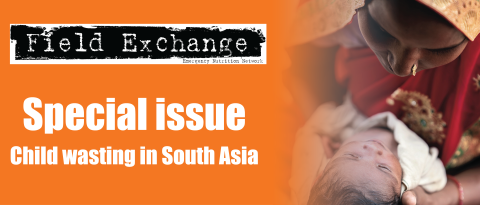Nutrition Exchange South Asia issues on maternal nutrition and complementary feeding
Nutrition Exchange (NEX)1 recently developed two regionally focused editions exploring maternal nutrition and improving young children’s diets in South Asia. These special issues followed on from two regional conferences jointly hosted by the United Nations Children’s Fund (UNICEF) and the South Asian Association for Regional Cooperation (SAARC) held in 2018 and 2019. NEX articles across both special issues highlight work being done in South Asian countries to improve maternal nutrition and improve young children’s diets through the development and mobilisation of an enabling policy, programme and financial environment – work that is fundamental for the prevention of child wasting.
Articles in the maternal nutrition edition reflect multi-sector efforts to improve nutrition counselling interventions, iron and folic acid (IFA) supplementation and access to antenatal care (ANC) services. Articles from Nepal, Afghanistan and Pakistan reflect the important role that community-based health workers (CHWs) play in improving maternal nutrition; largely through nutrition counselling and education services. In Bhutan this was extended to other service providers in a multi-sector response where non-health officials were employed to promote ANC care. Building the capacity of CHWs and other actors to offer maternal nutrition counselling is deemed essential in several articles in this issue, with many training programmes being updated to include maternal nutrition. In India it was found that less than one third of undergraduate medical students knew about maternal dietary diversity and the correct dose of IFA supplementation during pregnancy. The development of a maternal nutrition curriculum for medical students has been proposed in response. Social behaviour change interventions are also reflected in articles. In Sri Lanka, in order to reach women pre-conception, newly married couples are invited to a pre-pregnancy care programme when they register their marriage. The programme includes education on maternal diet, including overnutrition and its potential implications for offspring. In Nepal, understanding that fathers play a major role in household decision-making, a motivational ‘letter to the father’ from the unborn baby is given to households during ANC visits to explain the role fathers can play during pregnancy and in raising a well-nourished child. An article from Karnataka State in India outlines another option to improve maternal nutrition; a hot mid-day meal provided at Anganwadi centres for pregnant women to increase their calorie intake. Finally, articles from Bangladesh and Pakistan reflect the need to include data on maternal nutrition to understand the coverage and quality of services.
The issue on complementary feeding again reflects the importance of nutrition education and counselling by CHWs as a mechanism to improve diet diversity (as noted in Punjab, Pakistan and Bihar, India), as well as engaging more broadly with individual mothers, caregivers and, importantly, their influencers through text messages and social media. A multi-sector communication messages booklet on nutrition was developed for this purpose in Pakistan. In Afghanistan a positive deviance/hearth model is used to identify parents of children whose mid-upper arm circumference is in the ‘green zone’ as role models. These parents are requested to share their positive child-feeding practices with other parents. In Sindh, Pakistan water, sanitation and hygiene (WASH) and nutrition messaging are combined to improve diets and feeding practices for young children. Articles reflect the importance of combining counselling and social behaviour change communication (SBCC) with cash transfers to overcome barriers to affordability of high-quality foods (Nepal and Bangladesh). In India, instead of cash-based transfers, food supplementation through Anganwadi centres is used. In Nepal homestead food production support increases access to fresh foods for vulnerable families. In food-insecure populations, complementary food supplements, agriculture interventions and/or cash transfers can play an important role in supporting infant feeding.
A strong theme running through these publications is the importance of context-specific understanding of the perceptions and realities for families and communities. While the extent to which such interventions impact on wasting and stunting rates remains unclear, the stories in both editions offer powerful examples of potential mechanisms to prevent child undernutrition in South Asia.
1 Nutrition Exchange is an ENN publication that contains short, non-technical and easy-to-read articles on nutrition programme experiences and learning geared to individuals working to reduce levels of undernutrition at national, district and community levels.


